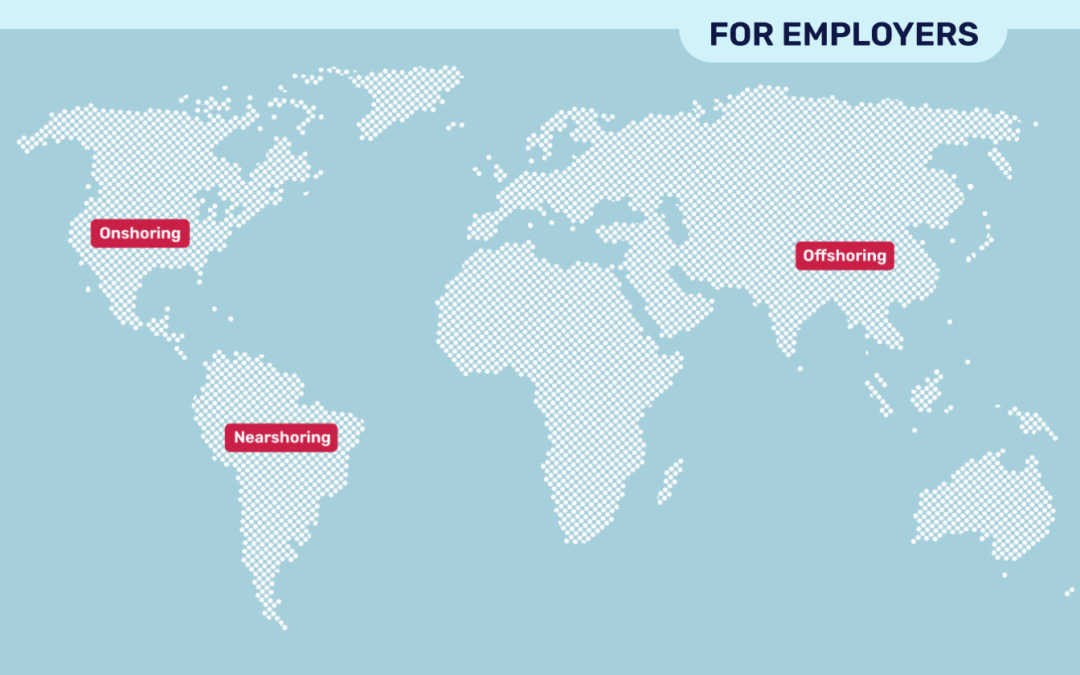
Onshore vs offshore vs nearshore
Onshoring vs nearshoring vs offshoring: what is right for your business?

In today’s globalized economy, businesses have more options than ever when it comes to expanding their operations and optimizing costs. Whether you are a startup looking to scale or an established enterprise seeking efficiency, the decision between onshoring, nearshoring, and offshoring can significantly impact your company’s success. But how do you determine which approach is right for your business?
This blog will explore the details of onshoring, nearshoring, and offshoring to help you make an informed decision. We will delve into the advantages and challenges of each strategy, offer real-world examples, and discuss how recruitment agencies like Top Latin Talent can help you find the right talent, no matter which approach you choose.
Understanding onshoring, nearshoring, and offshoring
Before discussing the advantages and disadvantages, it’s important to define onshoring, nearshoring, and offshoring.
- Onshoring: This involves keeping business processes within your home country. For U.S. companies, this means working with domestic talent and resources. It offers the highest level of control and aligns with local regulations but often comes at a higher cost.
- Nearshoring: Nearshoring refers to relocating business processes to a nearby or neighboring country, often within the same or similar time zone. For U.S. businesses, this might mean working with partners in Latin America or Canada. It balances cost savings with geographical proximity and cultural alignment.
- Offshoring: Offshoring involves moving business processes to a distant country, typically across continents. Countries like India, China, and the Philippines are common offshoring destinations due to their lower labor costs. While it offers significant cost savings, it can also present communication and quality control challenges.

Evaluating the benefits of onshoring, nearshoring, and offshoring
1. The benefits of nearshoring
Nearshoring offers a middle ground between the cost-effectiveness of offshoring and the control of onshoring. It’s a strategy that many U.S. companies find appealing, especially when looking to Latin America or Canada for talent.
Cost savings with proximity
Nearshoring offers significant cost savings compared to onshoring, though typically not as low as offshoring. However, the proximity to your home country often justifies the slightly higher costs. You benefit from lower labor costs while enjoying the advantages of a nearby location.
Cultural alignment
Cultural similarities between your home country and the nearshoring destination can lead to smoother collaboration. Shared business practices, language skills, and work ethics reduce the chances of miscommunication and help build stronger working relationships.
Convenient time zones
Nearshoring to countries in similar time zones facilitates real-time communication. This is crucial for projects that require frequent interaction between teams or when quick decision-making is essential.
Easier travel
The geographical proximity of nearshoring destinations makes it easier and more cost-effective for management to travel for site visits, training, or problem resolution. This can enhance collaboration and ensure better alignment with your business objectives.
Ideal scenarios for nearshoring
Nearshoring is ideal for businesses that must balance cost savings with operational efficiency. It’s beneficial for collaborative projects, customer service operations, and IT development where time zone alignment is critical.
2. The benefits of offshoring
Companies often choose offshoring to minimize costs, access a global talent pool, and scale operations quickly. It’s a strategy that has been embraced by many industries, from manufacturing to IT services.
Maximum cost savings
Offshoring offers the most significant cost savings due to the lower labor costs in countries like India, China, and the Philippines. This makes it an attractive option for labor-intensive tasks such as manufacturing, customer service, and data entry.
Access to global talent
Offshoring provides access to a vast global talent pool, especially for specialized skills that may not be readily available domestically. For instance, many companies offshore IT development to India due to its large and highly skilled workforce.
24/7 operations
Thanks to time zone differences, offshoring can enable 24/7 operations. Work can be done overnight in the offshore location, leading to faster turnaround times and increased productivity.
Scalability
Offshoring offers flexibility to scale operations up or down depending on business needs. This is particularly useful for companies experiencing rapid growth or fluctuating demand.
Ideal scenarios for offshoring
Offshoring is best suited for companies that prioritize cost savings and require access to specialized skills. It’s also ideal for processes that can be standardized and don’t require real-time collaboration.
3. The benefits of onshoring
Onshoring, or domestic outsourcing, is often chosen by companies prioritizing quality, control, and compliance. Here’s why:
Quality control and oversight
Onshoring allows businesses to maintain a high level of quality control. When your operations are based domestically, monitoring processes, enforcing standards, and ensuring compliance with local regulations is easier. This is particularly important in industries like healthcare, finance, and manufacturing, where quality and safety are paramount.
Reduced risk
Operating within your home country minimizes risks associated with political instability, currency fluctuations, and legal challenges. You’re also more familiar with the local business environment, which can reduce the likelihood of unexpected issues.
Seamless communication
Communication is typically smoother and more effective with no language barriers and the same time zones. This leads to quicker decision-making and fewer misunderstandings, which can be critical in fast-paced industries.
Economic contribution
Onshoring supports the local economy by creating jobs and contributing to domestic economic growth. This can enhance your company’s reputation as a responsible corporate citizen.
Ideal scenarios for onshoring
Onshoring is particularly suitable for high-stakes projects, where quality and compliance are non-negotiable. It’s also a good choice for companies that require close collaboration between teams and clients or need to adhere to stringent regulatory standards.
Challenges to consider
While each approach has its benefits, there are also challenges to consider. Understanding these will help you mitigate risks and make more informed decisions.
Onshoring challenges
- Higher Costs: The primary downside of onshoring is the higher cost of labor and operations within the home country.
- Limited Talent Pool: Depending on your industry, you may find it challenging to source specific skills domestically.
Nearshoring challenges
- Moderate Cost Savings: While nearshoring is cheaper than onshoring, it doesn’t offer the same level of savings as offshoring.
- Cultural and Legal Differences: Despite being geographically close, there can still be cultural and legal differences that require careful management.
Offshoring challenges
- Communication Barriers: Language differences and time zone gaps can lead to miscommunication and delays.
- Quality Control: Ensuring consistent quality can be challenging when operations are far from the home office.
Political and Economic Risks: Offshoring involves exposure to risks related to political instability, regulatory changes, and currency fluctuations in the host country.
How recruitment agencies can help
Whether you choose onshoring, nearshoring, or offshoring, working with a specialized recruitment agency can simplify the hiring process and help you find the right talent. Here’s how different agencies can assist with each approach:
Nearshoring recruitment
Top Latin Talent specializes in connecting U.S. companies with highly skilled professionals in Latin America. We understand the cultural and operational nuances of the region, helping you find the right talent quickly and efficiently. Nearshoring with Top Latin Talent perfectly balances cost savings, cultural alignment, and operational efficiency.
Other agencies, such as Michael Page and Alto Impacto, also focus on Latin America, providing access to a diverse talent pool across the region.
Onshoring recruitment
For onshoring, agencies like Robert Half and Kelly Services are well-known in the U.S. for their extensive networks of domestic talent. These agencies can help you find skilled professionals within your home country, ensuring quality and compliance with local regulations.
Offshoring recruitment
For offshoring, agencies like MicroSourcing and Outsourced are leaders in connecting businesses with global talent, particularly in the IT and business process outsourcing (BPO) sectors. These firms provide comprehensive offshoring solutions, offering access to skilled professionals in countries like the Philippines, while focusing on cost efficiency and quality service.
Are you looking to hire Latin American talent? Schedule a commitment-free meeting today with us to discuss your hiring needs.






